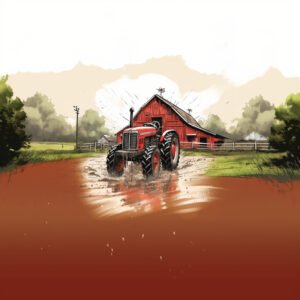**Raising Livestock in the Pacific Northwest: Best Practices**
The Pacific Northwest (PNW) is a region of breathtaking landscapes, from its rugged coastlines to its dense forests and majestic mountains. But for farmers, this beauty comes with its own set of challenges, especially when raising livestock. The temperate climate, characterized by wet winters and dry summers, can both benefit and challenge livestock management. Let’s delve into the best practices for raising livestock in the PNW, ensuring both their health and productivity.
**Understanding the PNW Climate**
Before diving into livestock management, it’s essential to understand the PNW climate. The region typically experiences mild temperatures, but the high precipitation, especially during winter months, can pose challenges for livestock health, ranging from muddy pastures to potential disease outbreaks.
**Selecting the Right Breeds**
1. **Cattle:** Consider breeds like Hereford, Angus, or Devon, known for their hardiness and adaptability. These breeds tend to fare well in the PNW’s wet conditions.
2. **Sheep:** Breeds such as Romney and Coopworth have wool that can handle the dampness better than others.
3. **Poultry:** For chickens, consider the Barred Rock or Rhode Island Red, both of which are hardy and lay well in cooler climates.
4. **Pigs:** Breeds like the Large Black or Tamworth are known for their adaptability to various climates and terrains.
**Managing Wet Seasons**
1. **Proper Shelter:** Ensure that barns and shelters are waterproof and well-ventilated. This keeps the animals dry and reduces the risk of respiratory issues.
2. **Mud Management:** Consider gravel or sand walkways, raised feeding areas, and proper drainage to prevent excessive mud, which can lead to hoof problems.
3. **Pasture Rotation:** Regularly rotate pastures to prevent overgrazing and soil compaction, especially during wet months.
4. **Health Checks:** Wet conditions can lead to fungal infections, parasites, and other health issues. Regular health checks and veterinary visits are crucial.
**Nutrition and Feeding**
1. **Forage:** The PNW offers lush pastures, but during wetter months, ensure that the forage doesn’t get too trampled or muddy. Supplement with hay if necessary.
2. **Balanced Diet:** Ensure a balanced diet appropriate for each livestock type. This might include grains, minerals, and vitamins, especially during the colder months when natural forage might be scarce.
**Additional Tips for Success**
1. **Fencing:** Use sturdy fencing to protect livestock from potential predators like coyotes or cougars, which are prevalent in the PNW.
2. **Community Engagement:** Connect with local farmers and livestock groups. Sharing experiences and knowledge can be invaluable.
3. **Education:** Stay updated with the latest research and practices. Institutions like Washington State University often provide resources and workshops tailored to the PNW farming community.
In conclusion, while the Pacific Northwest presents its own set of challenges for livestock farming, with the right knowledge and practices, it can be an incredibly rewarding experience. The key lies in understanding the unique climate, selecting the right breeds, and ensuring their health and well-being throughout the year. With dedication and passion, raising livestock in the PNW can be both a fulfilling and prosperous endeavor.
Understanding the PNW Climate
Before diving into livestock management, it’s essential to understand the PNW climate. The region typically experiences mild temperatures, but the high precipitation, especially during winter months, can pose challenges for livestock health, ranging from muddy pastures to potential disease outbreaks.
Selecting the Right Breeds
- Cattle: Consider breeds like Hereford, Angus, or Devon, known for their hardiness and adaptability. These breeds tend to fare well in the PNW’s wet conditions.
- Sheep: Breeds such as Romney and Coopworth have wool that can handle the dampness better than others.
- Poultry: For chickens, consider the Barred Rock or Rhode Island Red, both of which are hardy and lay well in cooler climates.
- Pigs: Breeds like the Large Black or Tamworth are known for their adaptability to various climates and terrains.
Managing Wet Seasons
- Proper Shelter: Ensure that barns and shelters are waterproof and well-ventilated. This keeps the animals dry and reduces the risk of respiratory issues.
- Mud Management: Consider gravel or sand walkways, raised feeding areas, and proper drainage to prevent excessive mud, which can lead to hoof problems.
- Pasture Rotation: Regularly rotate pastures to prevent overgrazing and soil compaction, especially during wet months.
- Health Checks: Wet conditions can lead to fungal infections, parasites, and other health issues. Regular health checks and veterinary visits are crucial.
Nutrition and Feeding
- Forage: The PNW offers lush pastures, but during wetter months, ensure that the forage doesn’t get too trampled or muddy. Supplement with hay if necessary.
- Balanced Diet: Ensure a balanced diet appropriate for each livestock type. This might include grains, minerals, and vitamins, especially during the colder months when natural forage might be scarce.
Additional Tips for Success
- Fencing: Use sturdy fencing to protect livestock from potential predators like coyotes or cougars, which are prevalent in the PNW.
- Community Engagement: Connect with local farmers and livestock groups. Sharing experiences and knowledge can be invaluable.
- Education: Stay updated with the latest research and practices. Institutions like Washington State University often provide resources and workshops tailored to the PNW farming community.
In conclusion, while the Pacific Northwest presents its own set of challenges for livestock farming, with the right knowledge and practices, it can be an incredibly rewarding experience. The key lies in understanding the unique climate, selecting the right breeds, and ensuring their health and well-being throughout the year. With dedication and passion, raising livestock in the PNW can be both a fulfilling and prosperous endeavor.

